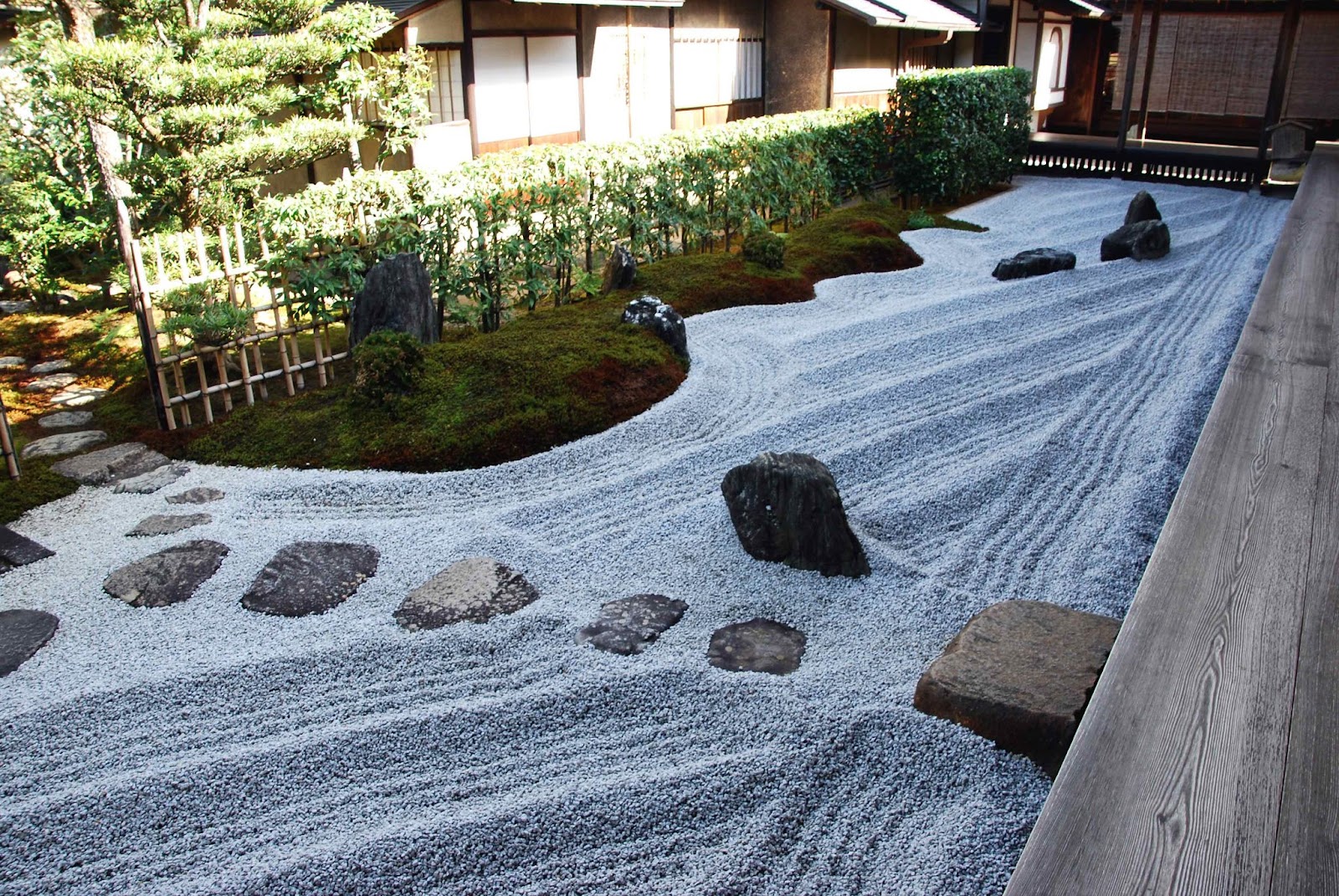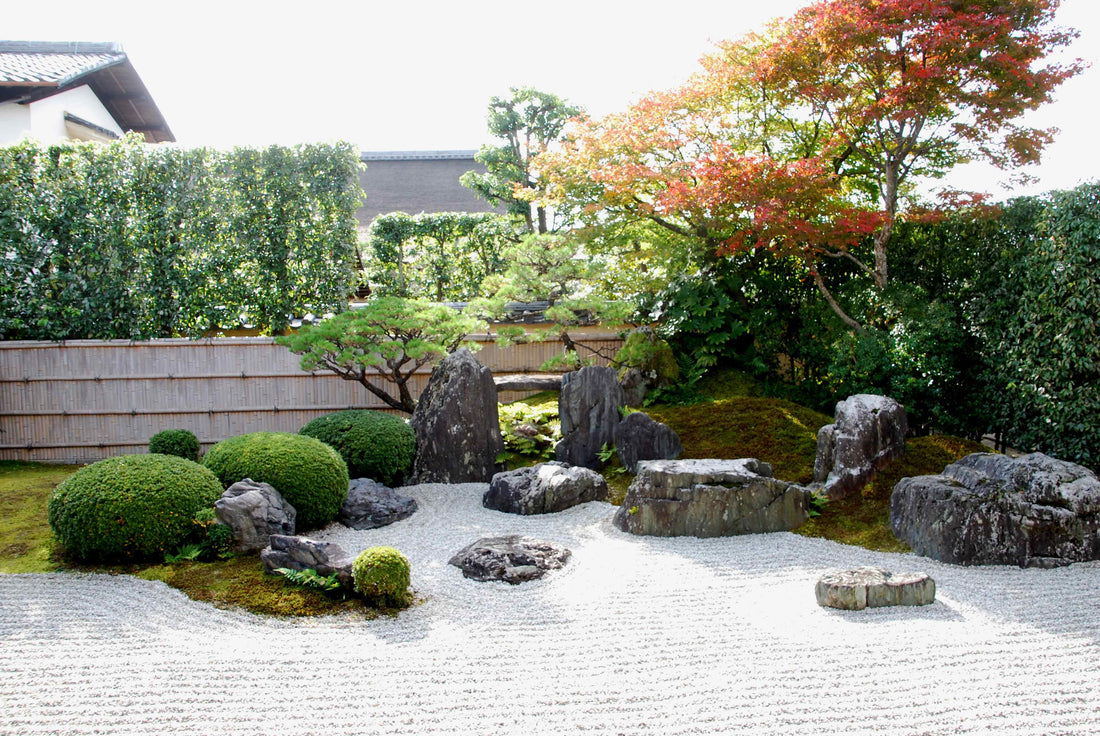Quick Tips for Designing Japanese Gardens:
A low-maintenance Japanese garden uses simple elements like stone, gravel, evergreen plants, and water features to create a peaceful, natural space. Rooted in harmony and intention, this garden style offers year-round beauty with minimal upkeep—perfect for those who want a calming retreat without the stress of constant maintenance.
The Beauty of Simple Gardening
A well-designed Japanese garden is a serene space that honors simplicity, stillness, and a deep respect for nature. Unlike traditional landscaping designs filled with fussy blooms or rigid designs, a Japanese-style garden grows with purpose and natural beauty. Every stone, plant, and patch of gravel has a role. The result is an outdoor space that feels intentional, timeless, and calm.
What is a Japanese Garden?
Japanese garden design follows a philosophy of harmony between people, plants, and place. It draws on natural elements like stone, water, and evergreen plants to create balance and flow. This style doesn’t rely on seasonal changes of color or heavy maintenance. It encourages us to slow down and appreciate the subtle beauty of shifting light, textured foliage, or the ripple of wind through bamboo.
For gardeners who want something beautiful yet easy to care for, Japanese gardens are an excellent choice. You don’t need to chase blooms or battle weeds constantly to have a space that feels alive and well-loved. With the right elements, you can create a peaceful retreat that practically cares for itself.
At Singing Tree Gardens, we’re drawn to this style for how it reflects our values: growing with intention, respecting the rhythm of the land, and working with nature. Whether you’re planting a single Japanese Black Pine or crafting a Zen-inspired space, we believe in starting with care and letting nature do what it does best.
Start with Stillness — Design Elements That Ground You
Stillness is one of the basic principles of traditional Japanese gardens. It doesn’t require constant movement or bursts of color to feel alive. The design relies on subtle textures and intentional placement to create quiet, grounded beauty.
Gravel and Raked Sand (Karesansui)
Symbolizing water, raked gravel paths or sand is a central element in dry gardens. These Zen gardens often use angular granite chips that hold their lines and resist shifting. With just occasional raking to refresh the design and remove leaves, this element stays neat and calming. Curved lines can represent gentle waves, while straight lines suggest still water. The motion of raking becomes part of the meditative experience.
Stones and Boulders
Larger rocks offer stability. Placed thoughtfully, they become anchors that tie the garden together. Whether used in clusters, as accents, or as focal points, stones represent the enduring quality of nature. They ask for almost nothing in return. A gentle rinse or clearing of debris now and then is all the care they need. Choose pieces with organic shapes, and let their natural textures contrast with soft plantings and smooth gravel.
Simple Paths with Stepping Stones
A line of natural stones can lead you around a corner, through a shaded grove, or past a water basin. These paths feel intentional and scaled for reflection. Spaced to match a natural stride and laid into gravel, mulch, or moss, they blend into the landscape.
Together, these elements create a pleasing visual and offer a space to breathe. With minimal maintenance and lasting materials, they provide structure and serenity, no matter the season.
Plants with Purpose — Choosing the Right Green Companions
In a Japanese-style garden, plants are chosen for form, texture, and the feeling they create. The goal is to calm the senses. Every plant has a role—whether it provides structure, softens edges, or invites quiet observation. Low-maintenance species with timeless beauty make it easy to enjoy the space without constant tending.
Evergreen Shrubs & Small Trees
Japanese boxwood, dwarf pines, and azaleas offer a tidy, sculpted look with very little work once established. Occasional pruning helps maintain shape. Limiting the plant palette enhances visual calm and keeps upkeep manageable. At Singing Tree Gardens, we especially love:
- Japanese Black Pine – Structured, iconic, and full of character
- Azaleas and Rhododendrons – Seasonal bursts of color without overwhelming the design
- Dwarf and Miniature Conifers – Compact, elegant, and perfect for defining space
Moss and Grass
Moss brings lush coverage to shady, moist spots and suppresses weeds. In full sun areas, try mondo ornamental grass or creeping thyme. Both require little watering once established and soften walkways beautifully.
Bamboo
Clumping bamboo offers gentle movement, height, and privacy. Unlike running varieties, these won’t spread aggressively. They blend naturally with the surrounding elements.
Together, these plant selections create depth and rhythm without demanding constant attention. The best part? Every choice reflects a garden that’s growing in harmony with the land, not fighting against it.
Singing Tree Gardens Favorites for Zen Spaces:
Explore our curated collection of Japanese maples, dwarf conifers, and woodland shrubs- perfect for designing with peace in mind.
Water Features Without the Work
Water is a visual interest in Japanese gardens, often symbolizing renewal, reflection, and flow. But incorporating water doesn’t mean committing to a small pond or fountain. With thoughtful choices, you can enjoy the gentle presence of water with
out extra effort.
Tsukubai Basin
A small basin, or Tsukubai, is one of the simplest ways to introduce water. Traditionally placed near a path or under a tree, these stone basins invite quiet moments of hand-washing or reflection. They require no plumbing—just occasional rinsing and topping off with fresh water. Some gardeners add a small bamboo ladle for a touch of authenticity.
Reflective Bowl or Recirculating Pump
If you’re drawn to movement and sound, consider a reflective bowl with a low-maintenance recirculating pump. Today’s solar-powered options work beautifully for smaller setups. They provide the soft trickle of water with minimal upkeep and no electrical wiring. Just keep them clean and filled, and they’ll do the rest.
Water elements bring life to a garden. They reflect the sky, attract birds, and soothe the mind. By choosing simple, elegant features, you can enjoy all the beauty of water without the work of managing a full koi pond or stream.
Designing with Nature in Mind
A true Japanese garden doesn’t try to control nature, it works with it. Rather than forcing rigid shapes or unnatural arrangements, this design philosophy lets plants grow in their natural forms, supported by healthy soil and thoughtful placement. The result is a space that feels alive, balanced, and easy to care for.
Soil
Start with the soil. Healthy plants begin with a healthy foundation. At Singing Tree Gardens, we grow everything in organic, compost-enriched soil, crafted to support long-term growth and strong root systems. Using natural mulch in your garden beds can help hold in moisture, reduce weeds, and slowly feed the soil as it breaks down.
Plant Maintenance
When it comes to plant maintenance, the less you interfere, the better. Let trees branch naturally. Let moss spread where it wants to. A Japanese garden thrives when it looks like it could have grown that way on its own. Minimal pruning and gentle seasonal cleanup are all that’s needed.
Sustainable Planting
This approach doesn't just create a low-maintenance garden, it’s sustainable. By choosing plants suited to your space and tending them with compost instead of chemicals, your garden becomes part of the ecosystem. Birds, bees, and beneficial insects will find their way in, adding quiet life to the scene.
The beauty of designing with nature in mind is that it removes the pressure to constantly “fix” things. You can enjoy your garden as it grows, trusting that what’s good for the earth will be good for your space, too.
 Tips to Keep It Low-Maintenance
Tips to Keep It Low-Maintenance
A Japanese garden is beautiful by design, but it’s also smart. With a few intentional choices, you can set yourself up for a garden that looks polished and peaceful without needing constant work.
- Choose native or climate-adapted plants
- Group plants by water needs
- Focus on structure and foliage over blooms
- Use durable, stable materials like granite gravel
- Avoid aggressive species like running bamboo
In terms of upkeep, here’s all you’ll likely need:
- Occasional raking of gravel or sand
- Light pruning once or twice a year
- Watering as needed (especially when plants are first settling in)
- Occasional debris removal or mulch refreshing
When designed with intention, a garden becomes a peaceful space that gives more than it takes.
Cultivating Peace, One Plant at a Time
A Japanese garden is a quiet invitation to slow down. In a world that often moves too fast, these spaces remind us to breathe, to notice, and to appreciate the gentle details: the curve of a stone, the hush of wind through pine needles, the soft glow of moss after a rain.
The emotional impact is easy to feel. Even one calm corner in a yard can shift your mood. A simple path, a stone basin, or a thoughtfully chosen conifer can start the transformation.
At Singing Tree Gardens, we believe in nurturing life, naturally. Every plant we offer is chosen with care and grown in harmony with the land. If a Japanese garden calls to you—whether it’s a smaller garden or a full landscape—we’re here to help you bring that vision to life.
Browse our curated collections of plants for Japanese Gardens or check out our garden ideas to spark inspiration. With the right plants and a thoughtful start, you can cultivate a space that brings lasting peace, one rooted in intention, harmony, and natural care.
